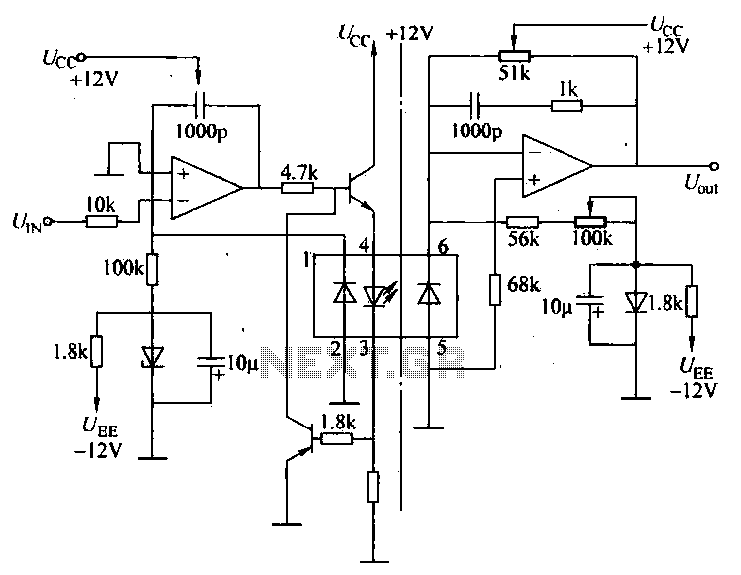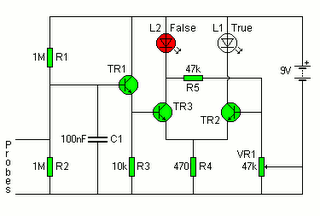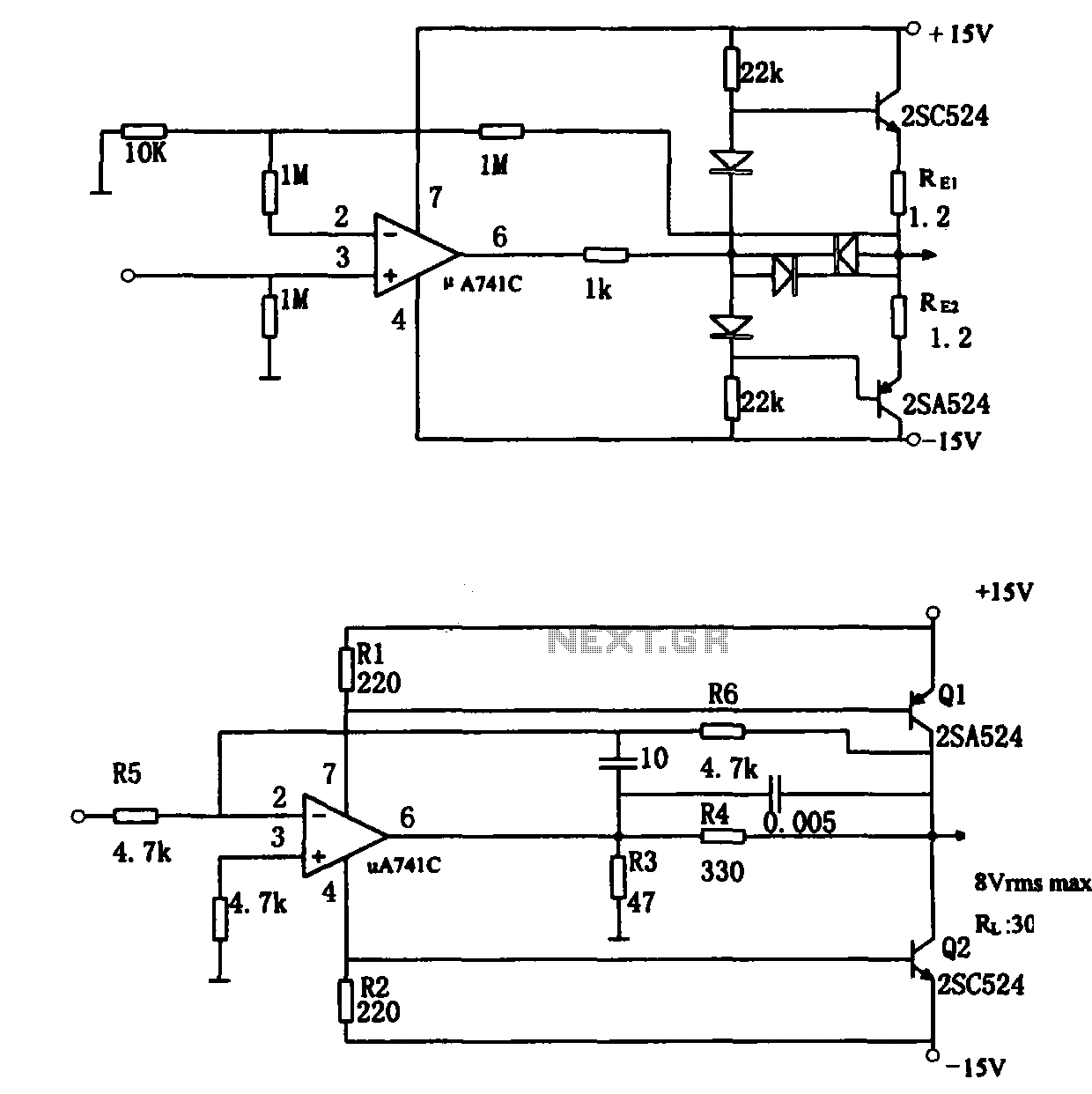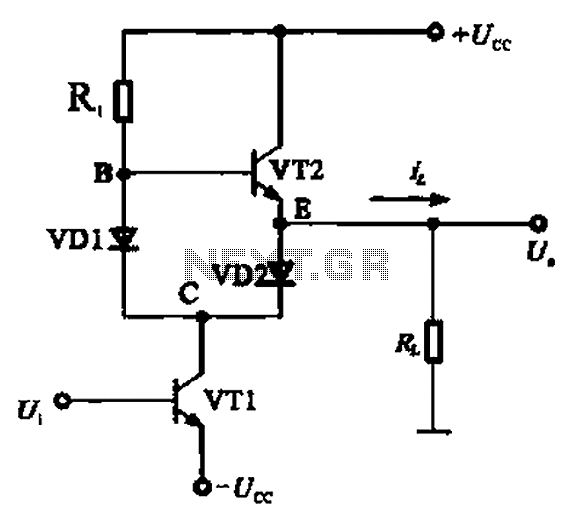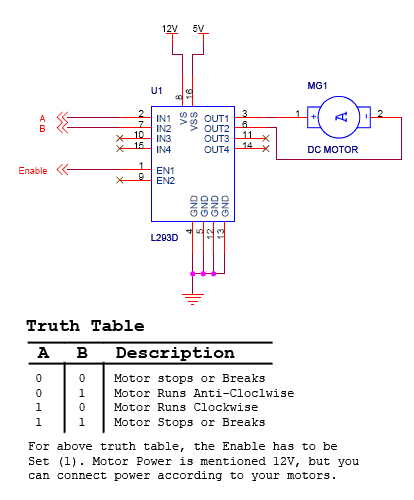
Video-Out Coupling

To connect a video signal to multiple destinations, a distribution amplifier is required to match the 75-ohm video cable. This amplifier terminates the incoming cable at 75 ohms and provides several outputs, each maintaining a 75-ohm output impedance. Typically, this is accomplished by incorporating a 75-ohm series resistor in the output lead of each video operational amplifier (current-feedback amplifier). The operational amplifiers must be configured for a gain of 2 to achieve an insertion gain of 1 (0 dB). A drawback of this configuration is that if the amplifier or its power supply fails, no signal will be available at any of the outputs. This issue can be mitigated by utilizing a high input impedance amplifier, which can connect to a video line without requiring its own 75-ohm termination resistor. To reduce hum interference and voltage discrepancies between the cable shield and the circuit ground, the circuit takes advantage of the common-mode rejection of the operational amplifier, which can be optimized using resistor RG1. With the LT1396 video operational amplifier, a common-mode rejection ratio exceeding 40 dB can be achieved. The signal bandwidth of the circuit can be fine-tuned using trimmer potentiometers, reaching over 10 MHz, which is suitable for video signals. Due to the high-impedance connection to the video line, the video signal remains unaffected when the power supply for the coupled amplifier is turned off. Further information about the LT1396 can be found in its data sheet.
To effectively implement a video distribution amplifier circuit, the design must include several key components to ensure optimal performance. The circuit begins with the LT1396 operational amplifier, selected for its high-speed capabilities and superior common-mode rejection ratio. The input stage of the circuit should be designed to accommodate a 75-ohm video signal, ensuring that the signal integrity is maintained throughout the transmission.
The incoming video signal is fed into the non-inverting input of the LT1396, while the feedback network is configured to set the gain to 2. This configuration involves placing a resistor in series with the output to achieve the desired output impedance of 75 ohms. The output stage should include multiple output taps, each following the same impedance matching principles to ensure that the signal remains consistent across all outputs.
To enhance the circuit's resilience against power supply failures, a high input impedance design is recommended. This allows the amplifier to tap into the video line without the need for its own termination resistor, thereby reducing the risk of signal loss during power outages. The use of RG1, a resistor optimized for common-mode rejection, aids in minimizing interference that could arise from ground loops or voltage differences between the cable shield and the circuit ground.
Trimmer potentiometers should be integrated into the design to allow for fine adjustments of the bandwidth, ensuring that the circuit can handle frequencies exceeding 10 MHz, which is essential for high-quality video transmission. This feature is particularly beneficial in applications where signal clarity and fidelity are paramount, such as in broadcast or professional video environments.
Overall, the implementation of this distribution amplifier circuit provides a reliable solution for distributing video signals to multiple destinations while maintaining signal integrity and minimizing interference. The LT1396's specifications and performance characteristics make it an ideal choice for such applications, and careful attention to circuit design will yield a robust and effective video distribution system.If you want to connect a video signal to several destinations, you need a distribution amplifier to match the 75-ohm video cable. A distribution amplifier terminates the incoming cable in 75 ohms and provides several outputs, each with 75-ohm output impedance.
Since this is usually achieved by putting a 75-ohm series resistor in the output lead of each video opamp (current-feedback amplifier), the opamps must be set up for a gain of 2 in order to achieve an insertion gain of 1 (0 dB). The disadvantage of this arrangement is that if the amplifier or its power supply fails, no signal is available at any of the outputs.
This can be remedied by using a high input impedance amplifier, which can be tapped into a video line without having to have its own 75-ohm termination resistor. In order to eliminate hum interference and voltage differences between the cable screen and the circuit earth, the circuit exploits the common-mode rejection of the opamp.
This can be optimized with resistor RG1. With the indicated LT1396 video opamp, more than 40 dB of common-mode rejection can be achieved. The signal bandwidth of the circuit can be optimized using the trimpots. It reaches to more than 10 MHz, which is quite acceptable for video signals. Thanks to the high-impedance connection to the video line, the video signal is not affected when the power for the coupled amplifier is switched off. You can learn more about the LT1396 from its data sheet at 🔗 External reference
To effectively implement a video distribution amplifier circuit, the design must include several key components to ensure optimal performance. The circuit begins with the LT1396 operational amplifier, selected for its high-speed capabilities and superior common-mode rejection ratio. The input stage of the circuit should be designed to accommodate a 75-ohm video signal, ensuring that the signal integrity is maintained throughout the transmission.
The incoming video signal is fed into the non-inverting input of the LT1396, while the feedback network is configured to set the gain to 2. This configuration involves placing a resistor in series with the output to achieve the desired output impedance of 75 ohms. The output stage should include multiple output taps, each following the same impedance matching principles to ensure that the signal remains consistent across all outputs.
To enhance the circuit's resilience against power supply failures, a high input impedance design is recommended. This allows the amplifier to tap into the video line without the need for its own termination resistor, thereby reducing the risk of signal loss during power outages. The use of RG1, a resistor optimized for common-mode rejection, aids in minimizing interference that could arise from ground loops or voltage differences between the cable shield and the circuit ground.
Trimmer potentiometers should be integrated into the design to allow for fine adjustments of the bandwidth, ensuring that the circuit can handle frequencies exceeding 10 MHz, which is essential for high-quality video transmission. This feature is particularly beneficial in applications where signal clarity and fidelity are paramount, such as in broadcast or professional video environments.
Overall, the implementation of this distribution amplifier circuit provides a reliable solution for distributing video signals to multiple destinations while maintaining signal integrity and minimizing interference. The LT1396's specifications and performance characteristics make it an ideal choice for such applications, and careful attention to circuit design will yield a robust and effective video distribution system.If you want to connect a video signal to several destinations, you need a distribution amplifier to match the 75-ohm video cable. A distribution amplifier terminates the incoming cable in 75 ohms and provides several outputs, each with 75-ohm output impedance.
Since this is usually achieved by putting a 75-ohm series resistor in the output lead of each video opamp (current-feedback amplifier), the opamps must be set up for a gain of 2 in order to achieve an insertion gain of 1 (0 dB). The disadvantage of this arrangement is that if the amplifier or its power supply fails, no signal is available at any of the outputs.
This can be remedied by using a high input impedance amplifier, which can be tapped into a video line without having to have its own 75-ohm termination resistor. In order to eliminate hum interference and voltage differences between the cable screen and the circuit earth, the circuit exploits the common-mode rejection of the opamp.
This can be optimized with resistor RG1. With the indicated LT1396 video opamp, more than 40 dB of common-mode rejection can be achieved. The signal bandwidth of the circuit can be optimized using the trimpots. It reaches to more than 10 MHz, which is quite acceptable for video signals. Thanks to the high-impedance connection to the video line, the video signal is not affected when the power for the coupled amplifier is switched off. You can learn more about the LT1396 from its data sheet at 🔗 External reference
